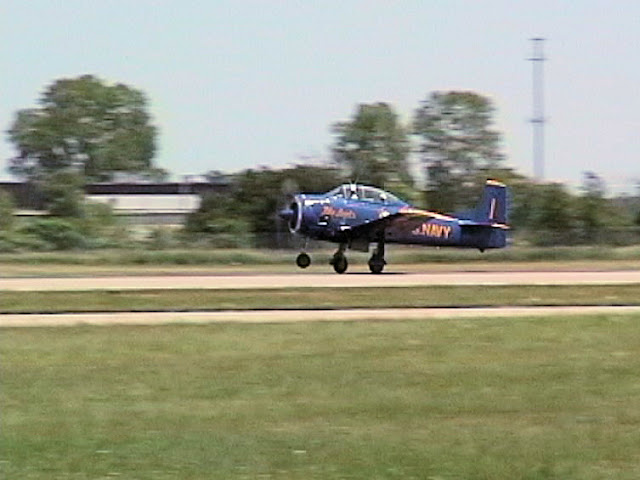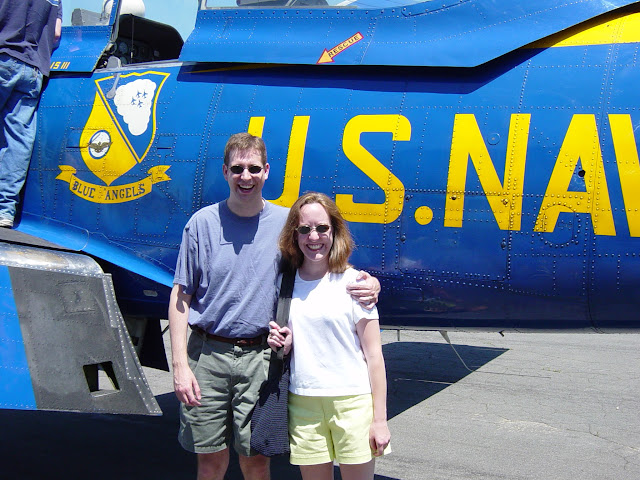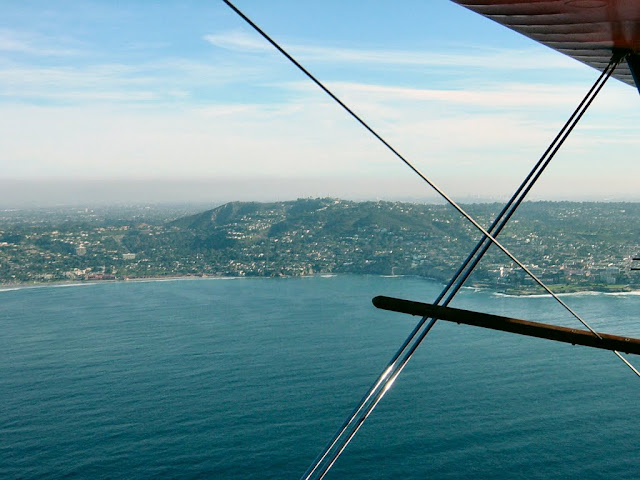On December 13 2003, I visited the McClellan-Palomar Airport, home to Barnstorming Adventures Ltd. Thanks to these fine folks, I spent about 40 minutes flying a restored 1929 Travel Air 4000 biplane over the Pacific coastline. Because most of my time was spent actually flying the aircraft, I took very few pictures.
NC674H is a 1929 Travel Air 4000 - a fabric-skinned historical artifact sporting a radial engine and a beautiful wooden prop. According to the folks at Barnstorming Adventures, this aircraft was originally flown by Chicago detectives and carried a bloodhound used to track the thugs that have become so emblematic of organized crime in early 20th century Chicago.
Once seated in the Travel Air, I looked to my right and noticed a T6 Texan sitting on the ramp nearby - another one of the toys belonging to Barnstorming Adventures.
Once established at a cruise altitude of 1500 feet, I took over the controls and directed the biplane south along the Pacific shoreline. Torn between wanting to sight-see and fly the airplane, I did several steep turns as we buzzed southward. At 85 mph, we would not even outrun a Cessna 150, but the ride was smooth, the airplane stable, and it was all tremendously fun.
La Jolla, home to the Pfizer R&D facility that brought me to California in the first place, sits on a peninsula that juts out into the Pacific Ocean. La Jolla marked the end of our southward trek; it was time to return to Palomar Airport. As we circled over the ocean, we watched a pair of dolphins playing below. Though difficult to see underwater, they would often break through the surface, streaking through the air momentarily before splashing back under the waves.
Once I acknowledged to Eric, the pilot in command, that I had captured a photo of La Jolla, he responded with "ok, your airplane". I took control of the stick again and began my customary scan for traffic. Immediately, I spotted a Piper Cherokee at 11 o' clock low climbing right toward us! Eric spotted him just as I did and immediately banked the biplane into a hard right turn. We later realized that we had been between the Piper and the sun, which probably made it virtually impossible for him to see us. A few minutes later, we spotted the Piper again, cruising along below us. Eric offered to take control again if I cared to snap a photograph of the, as he put it, "airplane that almost ruined [my] vacation".
I guided the biplane back to Palomar and flew the pattern until we were a few tens of feet above the runway. On short final, I surrendered the controls to Eric, who made a smooth wheel landing on the uphill grade of Palomar's runway 24. I couldn't have asked for a better way to spend a warm California winter afternoon!
Saturday, December 13, 2003
Monday, September 8, 2003
The 2003 National Air Tour Comes to Kalamazoo
The original National Air Tours were flown from 1925 to 1931. Sponsored by the Ford Motor Company, the events were intended to demonstrate the safety of air travel. The aircraft would depart Dearborn Michigan and fly a 4000 mile circuit through the Midwest, the South, and back along the eastern seaboard before returning to Dearborn. In 1926, the Kalamazoo Airport became Michigan's first municipal airport and established itself as the second stop on the tour. Unfortunately, the 1932 National Air Tour was canceled as the economy bottomed-out during the Great Depression.
The National Air Tour flew again on September 8, 2003 -- just in time for the Centennial of Flight. As before, Kalamazoo was the second stop for the tour of roughly 25 vintage aircraft. Kent, Dave, Daniel, and I played hooky from work to walk amongst these magnificent travelers from another age.
The Ryan M-1 was an open cockpit aircraft test flown by Charles Lindbergh during his search for an aircraft to carry him across the Atlantic. The Spirit of St Louis was a modified version of the M-1 with an enclosed cockpit and significantly augmented fuel capacity.
The instrument panel of the Ryan M-1 is reminiscent of (though more elegantly appointed than) the one in the Spirit of St Louis.
A 1929 Fokker Super Universal. The Fokker puns have been done to death, so I won't push my luck here..
Osa's Ark, a rare 1929 Sikorsky S-38 flying boat. Not long after I took this photo, this same airplane made the cover of AOPA Pilot (a good choice).
"The Spirit of Igor" was painted in a giraffe motif to match "The Spirit of Africa", a Sikorsky S-39 companion to "Osa's Ark" flown by Martin and Osa Johnson throughout Afica in the 1930's.
I was quite intrigued by the unusual coloration of the exhaust manifold on this 1930 Stinson SM-8A radial engine.
A spectacular biplane, the 1931 Stearman 4E Speedmail.
The National Air Tour logo adorns the nose of the Speedmail biplane.
A 1931 Stinson Trimotor, an elegant example of early commercial aviation.
Here's Kent with a 1928 Travel Air biplane.
Kent checks out a 1929 Buhl Sport Air Sedan.
This beautiful 1932 WACO UEC was flawless on the outside...
...and strikingly luxurious on the inside. I'm pretty sure that the GPS is not original equipment.
The National Air Tour flew again on September 8, 2003 -- just in time for the Centennial of Flight. As before, Kalamazoo was the second stop for the tour of roughly 25 vintage aircraft. Kent, Dave, Daniel, and I played hooky from work to walk amongst these magnificent travelers from another age.
The Ryan M-1 was an open cockpit aircraft test flown by Charles Lindbergh during his search for an aircraft to carry him across the Atlantic. The Spirit of St Louis was a modified version of the M-1 with an enclosed cockpit and significantly augmented fuel capacity.
The instrument panel of the Ryan M-1 is reminiscent of (though more elegantly appointed than) the one in the Spirit of St Louis.
A 1929 Fokker Super Universal. The Fokker puns have been done to death, so I won't push my luck here..
Osa's Ark, a rare 1929 Sikorsky S-38 flying boat. Not long after I took this photo, this same airplane made the cover of AOPA Pilot (a good choice).
"The Spirit of Igor" was painted in a giraffe motif to match "The Spirit of Africa", a Sikorsky S-39 companion to "Osa's Ark" flown by Martin and Osa Johnson throughout Afica in the 1930's.
I was quite intrigued by the unusual coloration of the exhaust manifold on this 1930 Stinson SM-8A radial engine.
A spectacular biplane, the 1931 Stearman 4E Speedmail.
The National Air Tour logo adorns the nose of the Speedmail biplane.
A 1931 Stinson Trimotor, an elegant example of early commercial aviation.
Here's Kent with a 1928 Travel Air biplane.
Kent checks out a 1929 Buhl Sport Air Sedan.
This beautiful 1932 WACO UEC was flawless on the outside...
...and strikingly luxurious on the inside. I'm pretty sure that the GPS is not original equipment.
Sunday, June 22, 2003
My Flight in a T-28 Trojan
One of the benefits of being an Air Zoo (Kalamazoo, MI) volunteer is a periodic flight in one of their airplanes. I had my first opportunity during the summer of 2003. The photos on this page are all captures from a video taken by Kristy.
My ride was in the Air Zoo's North American T-28 Trojan. After World War II, the T-28 replaced the T-6 Texan as a trainer for the Navy and Air Force. It was meant to transition pilots into jets and, as a result, was the first military trainer built with tricycle gear. It is powered by a nine-cylinder radial engine (Wright R-1820-86 Cyclone) developing 1,425 horsepower.
On tours, astute museum visitors often ask if the Blue Angels livery on the aircraft is authentic. Well...yes and no. The Blue Angels never flew T-28s. However, a former owner of the aircraft was a big fan of the Blue Angels and obtained their permission to outfit the T-28 with an accurate Blue Angels paint scheme. Thus, the paint job is authentic. It just doesn't belong on the T-28! But it's a beautiful paint job and the museum has not seen fit to redo it.
My ride was to be a part of the Air Zoo's Flight of the Day, where a brief demonstration flight is performed for museum guests.
At 2:00 on the afternoon of the appointed day, I met with the pilot, Dan Hamill. Dan gave me a brief overview of the routine he would fly before we went out to the ramp. Unfortunately, because of the nature of the routine, I would not be receiving any stick time.
As I was climbing into the back seat of the trainer, museum visitors were brought out onto the ramp where they could witness the starting of a radial engine up close and personal. Noticing that Kristy had a video camera to capture the event, Ron from the Air Zoo positioned her in front of the aircraft where she could get some nice footage of the start up.
I strapped myself in and donned a rather non-stylish white helmet (remember the helmets from "Spaceballs"?). As a trainer, the T-28 has a full instrument panel available in the back seat where an instructor would usually sit. I set the altimeter to the field elevation for Kalamazoo so that I could keep track of what was going on.
It was a hot day without a cloud in the sky. Dan warned me that he would leave the canopy open until the takeoff roll to keep from baking us both. No stranger to taxing around on hot days with the Cessna's door open, it sounded like a good idea to me.
Dan engaged the electric starter and the large prop began to turn slowly. The engine coughed a few times before suddenly catching with a puff of white smoke. Once he had the engine running smoothly, Dan contacted the tower and told them what we were planning. The tower noted that there was no one in the pattern and no commercial jet traffic expected anytime soon. "The airport's all yours," the tower controller finished. There's something very cool about receiving carte blanche from air traffic control while at the controls of a warbird.
Once cleared to depart, we took the runway and Dan closed the canopy. The instant greenhouse made things rather uncomfortable until we built up enough speed for the airvents to become effective. After climbing to pattern altitude, Dan made a tight right turn into a downwind for runway 35. I was amazed at the visibility afforded by the bubble canopy.
We lined up on approach and made our first pass along runway 35. Glancing at the instruments, I noted that we were flying at 200 knots (230 mph) about 100 feet off the runway surface. The museum flew past in a blur. Once we cleared it, Dan warned me that he was about to break to the left.
"Ok," I acknowledged, but I had no idea what was coming. The moment I responded, Dan initiated a knife-edge, climbing turn to the left. I felt like I was being crushed; like trying to wear an elephant as a hat. From the outside, I'm sure it was a crowd-pleaser.
"That was a 4-g turn," Dan commented matter-of-factly. As a seasoned military pilot, four g's were nothing to Dan. To an aerobatic newbie who tried to draw a breath of air right when the pull began, it was a bit overwhelming (but still WAY cool).
We made a gentle turn on to a left base for runway 35, directly over my office, then made a second low pass ending with a less-aggressive break to the right. Then, we lined up on runway 35 one last time and Dan executed a perfect (as far as I could tell) landing.
We taxied back and were met by our ground crew. As I removed my helmet, I could hear applause from the crowd.
It didn't last long, but it was quite a ride!
My ride was in the Air Zoo's North American T-28 Trojan. After World War II, the T-28 replaced the T-6 Texan as a trainer for the Navy and Air Force. It was meant to transition pilots into jets and, as a result, was the first military trainer built with tricycle gear. It is powered by a nine-cylinder radial engine (Wright R-1820-86 Cyclone) developing 1,425 horsepower.
 |
| Video / Photo by Kristy |
On tours, astute museum visitors often ask if the Blue Angels livery on the aircraft is authentic. Well...yes and no. The Blue Angels never flew T-28s. However, a former owner of the aircraft was a big fan of the Blue Angels and obtained their permission to outfit the T-28 with an accurate Blue Angels paint scheme. Thus, the paint job is authentic. It just doesn't belong on the T-28! But it's a beautiful paint job and the museum has not seen fit to redo it.
 |
| Video / Photo by Kristy |
My ride was to be a part of the Air Zoo's Flight of the Day, where a brief demonstration flight is performed for museum guests.
At 2:00 on the afternoon of the appointed day, I met with the pilot, Dan Hamill. Dan gave me a brief overview of the routine he would fly before we went out to the ramp. Unfortunately, because of the nature of the routine, I would not be receiving any stick time.
As I was climbing into the back seat of the trainer, museum visitors were brought out onto the ramp where they could witness the starting of a radial engine up close and personal. Noticing that Kristy had a video camera to capture the event, Ron from the Air Zoo positioned her in front of the aircraft where she could get some nice footage of the start up.
 |
| Video / Photo by Kristy |
I strapped myself in and donned a rather non-stylish white helmet (remember the helmets from "Spaceballs"?). As a trainer, the T-28 has a full instrument panel available in the back seat where an instructor would usually sit. I set the altimeter to the field elevation for Kalamazoo so that I could keep track of what was going on.
It was a hot day without a cloud in the sky. Dan warned me that he would leave the canopy open until the takeoff roll to keep from baking us both. No stranger to taxing around on hot days with the Cessna's door open, it sounded like a good idea to me.
Dan engaged the electric starter and the large prop began to turn slowly. The engine coughed a few times before suddenly catching with a puff of white smoke. Once he had the engine running smoothly, Dan contacted the tower and told them what we were planning. The tower noted that there was no one in the pattern and no commercial jet traffic expected anytime soon. "The airport's all yours," the tower controller finished. There's something very cool about receiving carte blanche from air traffic control while at the controls of a warbird.
 |
| Video / Photo by Kristy |
Once cleared to depart, we took the runway and Dan closed the canopy. The instant greenhouse made things rather uncomfortable until we built up enough speed for the airvents to become effective. After climbing to pattern altitude, Dan made a tight right turn into a downwind for runway 35. I was amazed at the visibility afforded by the bubble canopy.
We lined up on approach and made our first pass along runway 35. Glancing at the instruments, I noted that we were flying at 200 knots (230 mph) about 100 feet off the runway surface. The museum flew past in a blur. Once we cleared it, Dan warned me that he was about to break to the left.
 |
| Video / Photo by Kristy |
"Ok," I acknowledged, but I had no idea what was coming. The moment I responded, Dan initiated a knife-edge, climbing turn to the left. I felt like I was being crushed; like trying to wear an elephant as a hat. From the outside, I'm sure it was a crowd-pleaser.
 |
| Video / Photo by Kristy |
"That was a 4-g turn," Dan commented matter-of-factly. As a seasoned military pilot, four g's were nothing to Dan. To an aerobatic newbie who tried to draw a breath of air right when the pull began, it was a bit overwhelming (but still WAY cool).
We made a gentle turn on to a left base for runway 35, directly over my office, then made a second low pass ending with a less-aggressive break to the right. Then, we lined up on runway 35 one last time and Dan executed a perfect (as far as I could tell) landing.
We taxied back and were met by our ground crew. As I removed my helmet, I could hear applause from the crowd.
 |
| Photo by Kristy |
 |
| Photo by Ron |
It didn't last long, but it was quite a ride!
Subscribe to:
Posts (Atom)



















